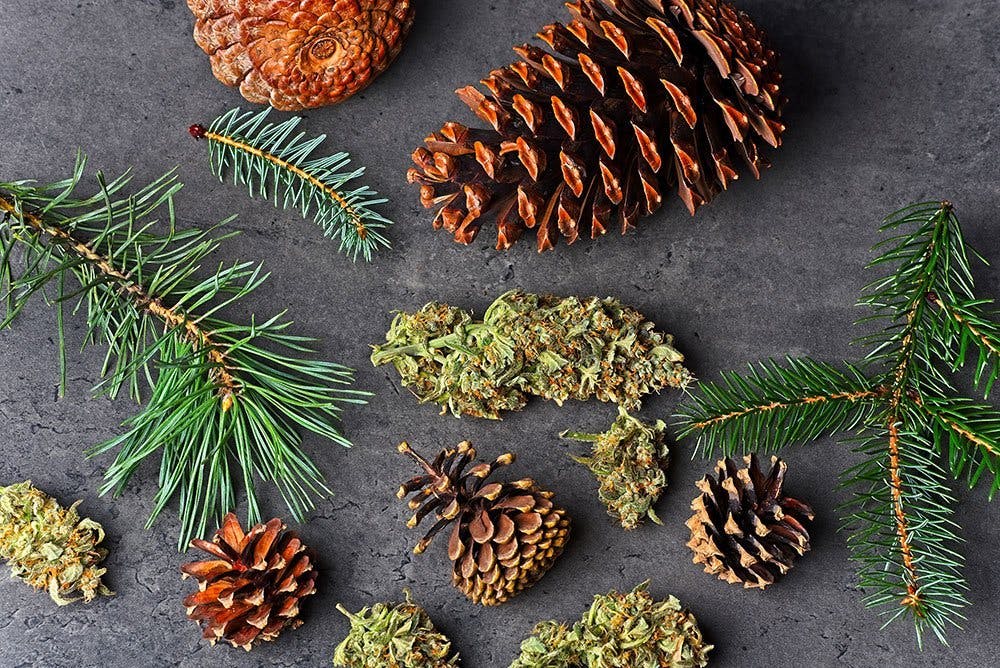Knowing more about terpenes will deepen your knowledge of cannabis, as cannabis is a heck of a lot more than just cannabinoids like THC and CBD. Terpenes are important building blocks for the molecular structure of cannabis, and are also integral in affecting the cannabis experience.
Terpenes are what you smell when you get close to a plant, since they are responsible for the plant’s fragrance and aroma. There are terpenes present in every plant, not just cannabis. When you cut into a lemon you immediately get a fresh, citrusy aroma; those are terpenes. If you grab the stalk of a tomato plant and smell your fingers, the molecules left on your hands are terpenes. If you smell a pine tree, that’s terpenes.
When you purchase cannabis at TOKE, you may hear us talk about the special “terpene profile” of a certain strain. The terpene profile is essentially the mix of the terpenes found in a cannabis bud, and how they all come together in harmony. There is something special and beautiful about terpene profiles and how they convey a message with just simple scent notes.
Terpenes work synergistically with all of the other compounds within the plant, to enact something called The Entourage Effect. Within this phenomenon, terpenes and cannabinoids work together in harmony to increase one another’s effectiveness.
Many cannabis testing facilities now test for terpene levels because of new research showing just how important terpenes are in the effect you feel from cannabis. As the cannabis consumer in Canada begins to catch on more about the importance of terpenes, we anticipate that we’ll be asked more about terpene profiles rather than THC content. Terps are that amazing!
We’ve gone through the research on terpenes, and have asked our staff to tell us some of their favourite terps. Here are 5 terpenes we’d like to profile:
Myrcene
The aroma of myrcene is earthy, musky, and herbal with notes of tropical fruits, which is why you’ll find myrcene in mangoes as well. The most commonly reported effect of myrcene is “couch lock”, meaning you can’t get your booty off the couch.
Myrcene is a sedative terpene, so you may find that an indica paired with a terp profile that contains myrcene may get you into a completely relaxed state, or even may have you snoozing before you know it!
Pinene
The aroma of pinene is, as you guessed, PINE. This terpene is also found in rosemary, pine needles, and basil.
Pinene can also help to counteract some of the adverse effects of THC, like paranoia.
Pinene is the most common terpene found in nature.
Blue Dream is a popular strain that you’ll find in Canada’s legal cannabis market, which is known to be rich in pinene.
Limonene
This terpene smells just like citrus, either like a fresh orange or a zesty lemon. Limonene is also found in rosemary, citrus fruit rinds, juniper, and peppermint.
Limonene is known for its energizing and mood enhancing properties. You’ll find Limonene is some of the “Lemon” strains, like Lemon Sour Diesel. When you find citrusy notes in your cannabis experience, make no mistake – that’s limonene!
Beta Caryophyllene
This terpene smells peppery and spicy, similar to cloves. B-Caryophyllene is unique in the sense that it’s the first known “dietary cannabinoid”, meaning that it is the only compound that is both a terpene and a cannabinoid.
This terpene binds to the endocannabinoid system in a similar way to THC or CBD, by selectively binding to the CB2 receptor.
An example of a B-caryophyllene strain is a very famous strain, GSC (a.k.a. Girl Scout Cookies), is usually very high in B-caryophyllene.
Here’s a fun fact: Because B-caryophyllene binds to the same receptors as cannabinoids, chewing or sniffing black pepper is one of the recommended ways to curb a THC high, alongside CBD.
Humulene
This terpene is commonly found in both cannabis and hops. Its aroma has earthy, woody, and spicy notes. It can also be found in black pepper and ginseng.
This terpene is an effective anti-inflammatory, anti-bacterial, and appetite suppressant. Humulene is not as common as other terpenes and is therefore not found in large quantities, but it still has a substantial effect. Humulene gets its name from the scientific name of the hops plant, Humulus Lupulus (hops and cannabis are in the same plant family: Cannabaceae).
Humulene is very close to b-caryophyllene in its effects, but they differ in their chemical structure. Additionally, humulene can help the growing cannabis plant ward off potential pests and prevent fungal infections within the plant.
Common strains containing relatively high levels of humulene are Headband, GG4 and Green Crack.
Explore Terpenes with TOKE
We’ve named just 5 of the potentially over 100 known terpenes in cannabis. Once you go down the rabbit hole of learning more about terpenes, you will literally change the way you look at your cannabis. Terpenes are just one part of what makes the cannabis plant fascinating, but they are one of the most important parts.
Next time you’re in a cannabis retail store, ask about terpene profiles. Maybe you’ve learned something here about some of the terpenes you’d like to find in your cannabis. We also encourage you to do your own research to see what others are saying about how terpenes affect the cannabis experience.
Cannabis isn’t just about the THC. It’s much more than that! We encourage you to familiarize yourself with cannabinoids and terpenes, as they are both equally important parts of your experience and the effects you’ll obtain from your cannabis products.
